-
Paper Information
- Next Paper
- Previous Paper
- Paper Submission
-
Journal Information
- About This Journal
- Editorial Board
- Current Issue
- Archive
- Author Guidelines
- Contact Us
Journal of Civil Engineering Research
p-ISSN: 2163-2316 e-ISSN: 2163-2340
2014; 4(2A): 17-22
doi:10.5923/c.jce.201401.04
Enhancing the Seismic Response of Buildings with Energy Dissipation Methods – An Overview
Shanmuga Priya D., Cinitha A., Umesha P. K., Nagesh R. Iyer
CSIR-Structural Engineering Research Centre, Chennai, India
Correspondence to: Shanmuga Priya D., CSIR-Structural Engineering Research Centre, Chennai, India.
| Email: |  |
Copyright © 2014 Scientific & Academic Publishing. All Rights Reserved.
In recent years many seismic protection systems have been developed to reduce the effects of the devastating wind and seismic loads. For this purpose, greater attention has been directed towards the use of passive energy dissipaters, base isolators, active and hybrid control systems. This paper reviews the existing energy dissipation systems that can be adopted to minimize the amount of damage and response of the structure during extreme dynamic loads. Based on the review, it is observed that passive systems such as tuned mass dampers, friction dampers, tuned liquid dampers are highly effective in moderate seismic zones and wind predominant regions. Base isolation technique decouples the structure from the ground preventing the superstructure from absorbing input energy and it is effective in low to medium rise buildings in hard soil. Seismic isolation systems contribute to safety by withstanding lateral forces also. Active vibration control systems are preferred more than passive control systems when flexibility and height of the buildings is to be considered. This paper highlights the behaviour of various forms of energy dissipation devices during seismic events for real time application in structures.
Keywords: Seismic isolation, Energy dissipation systems, Active vibration control, Tuned mass damper
Cite this paper: Shanmuga Priya D., Cinitha A., Umesha P. K., Nagesh R. Iyer, Enhancing the Seismic Response of Buildings with Energy Dissipation Methods – An Overview, Journal of Civil Engineering Research, Vol. 4 No. 2A, 2014, pp. 17-22. doi: 10.5923/c.jce.201401.04.
Article Outline
1. Introduction
- Minimum transmission of the damaging ground motions is possible by the introduction of energy dissipation devices which provides damping in to structural elements. Soong and Spencer (2002), Symans et al (2008), Whittaker et al (1991) and many more have carried out great work on the behaviour and design of energy dissipating devices and base isolators. Active or hybrid or semi-active control systems are force delivery devices integrated with real-time processing evaluators/controllers and sensors within the structure. Passive energy-dissipation system, leads the input energy from earthquake directly to the dissipation device, thereby reducing energy-dissipating demand on primary structural members and minimizing possible structural damage. Energy dissipating device operates on the principle of friction sliding, yielding of metals, phase transformation in metals, deformation of viscoelastic solids or fluids and fluid orifice. This paper reviews the behaviour of energy dissipation systems and their application to building structures for enhancing the seismic response of structures.
1.1. Classification of Energy Dissipation Systems
- Energy dissipation systems can be broadly classified in to the following category:● Passive control systems● Active control systems● Semi-active control systems● Base isolationPassive energy dissipaters are further classified into displacement-dependent devices (friction devices, metallic yielding devices) and velocity-dependent devices (solid viscoelastic and fluid viscous dampers). Active, hybrid and semi-active structural control system are a natural evolution of passive control technologies. The possible use of active control systems and some combinations of passive and active systems as a means of structural protection against seismic loads has received considerable attention in recent years. Base isolation is the process where rubber bearings are used to reduce structural movement by installing rubber pads between sub-structure and superstructure. Table 1 gives the summary of various energy dissipaters.
 | Table 1. Summary of energy dissipation devices [2] |
2. Passive Energy Dissipation Systems
- Passive energy dissipation systems absorb a part of input energy, reducing energy dissipation demand on primary structural members. Hysteresis devices (metallic and friction dampers) dissipate energy through a mechanism that is independent of load frequency. Metallic dampers dissipate energy through yielding of metals and friction dampers through sliding friction. Fig. 1 and 2 show the hysteresis devices respectively [3].
 | Figure 1. Metallic damper [4] |
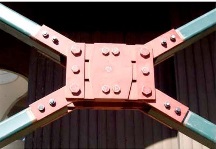 | Figure 2. Friction damper [4] |
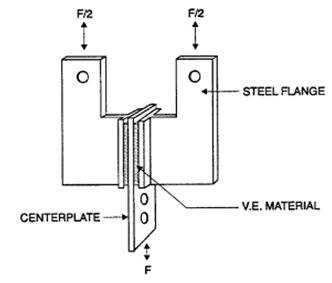 | Figure 3. Viscoelastic damper [1] |
 | Figure 4. Schematic view of passive control systems [1] |
2.1. Seismic Response of Metallic Dampers in Real-time Application
- Metallic dampers have a wide range of application in real-time structures due to its low cost. One such structure is illustrated below. The Art Hotel Sapporo is 96m high with 26 stories above ground and one underground. Primarily the structure was designed only to support vertical load. 2000 slit steel dampers (SSD) were used as shown in Fig. 5. When SSD is subjected to shear force, the bars between slits undergo bending and being of very small cross-section they yield by absorbing earthquake energy [9].
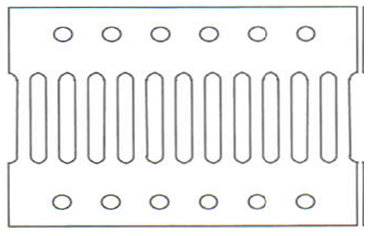 | Figure 5. Slit steel damper in Art Hotel, Sapporo [9] |
2.2. Seismic Response of Friction Dampers in Real-time Application
- Eaton’s building in Montreal was renovated in the year 2000 with 161 friction dampers. The friction dampers installed as diagonal and chevron bracing are shown in Fig. 6 when structure undergoes deformation, the friction dampers start dissipating energy. The forces on the structure were reduced and lateral shear at the base was transferred to the retaining walls of the basement. This high energy dissipating friction dampers reduces the damage to even nonstructural components [10].
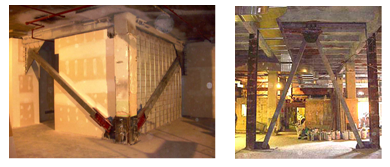 | Figure 6. Friction dampers installed as diagonal and chevron bracing [10] |
 | Figure 7. Response of friction damped system to seismic excitation [10] |
2.3. Seismic Response of Viscous Dampers in Real-time Structures
- St Francis Shangri-La Tower is a residential building of 210m tall and located in high seismic and typhoon region as shown in Fig. 8. A total of 16 dampers per building is installed to reduce the effects of the dynamic loading [11].
 | Figure 8. St. Francis Shangri-La Towers |
|
3. Active Control Systems
- In recent years, use of automated control to reduce the effects of dynamic loading on the structure is of great concern. Fig. 9 shows a schematic representation of the active control devices. The control forces are generated by actuators based on the feedback response from the structure [12].
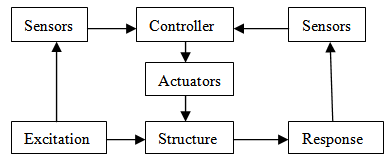 | Figure 9. Schematic representation of active control systems [1] |
3.1. Seismic Response of Active Control Devices in Real-time Application
- Nowadays large number of buildings in China, Japan and Tokyo are coming up with full scale implementation of active control devices. The Sendagaya INES building in Tokyo shown in Fig. 10 is an example of hybrid mass damper (HMD) which is a combination of Tuned mass damper and active control devices. The HMD is installed at the top floor consisting of two masses to control transverse and torsional motion of the structure.
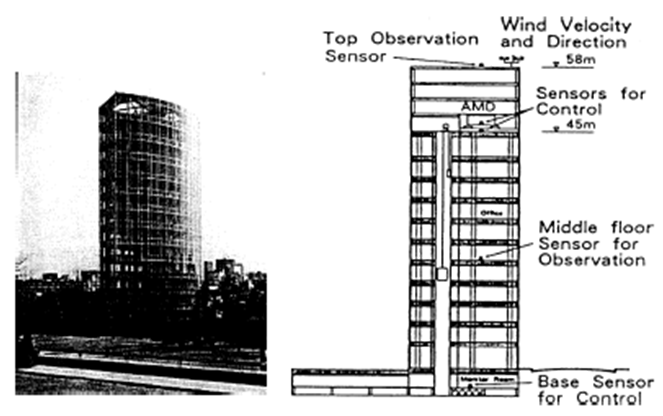 | Figure 10. Sendagaya INES building with HMD [1] |
 | Figure 11. Response of the building under translation and torsion [1] |
4. Semi-active Control System
- Semi-active control systems have originated from passive control systems as in both, the control forces are developed due to the motion of the structure. These devices require a small amount of external power and combine the features of active and passive control devices. A class of semi-active devices use controllable fluids namely electrorhoelogical (ER) and magnetorheological (MR) fluids. An important property of these fluids is their ability to reversibly change free flowing to semi-solid state when exposed to magnetic or electric field. Fig. 12 shows schematic representation of semi-active devices [13-14].
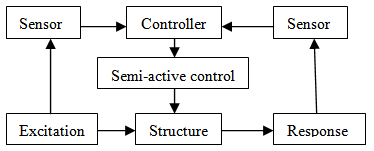 | Figure 12. Schematic representation of semi-active control system [1] |
4.1. Seismic Response of Semi-active Control Devices in Real-time Application
- The first full scale implementation of semi-active damper system is Kajima Shizuoka building in japan shown in Fig. 13.
 | Figure 13. Kajima Shizuoka building with semi-active hydraulic damper installed on the sides [15] |
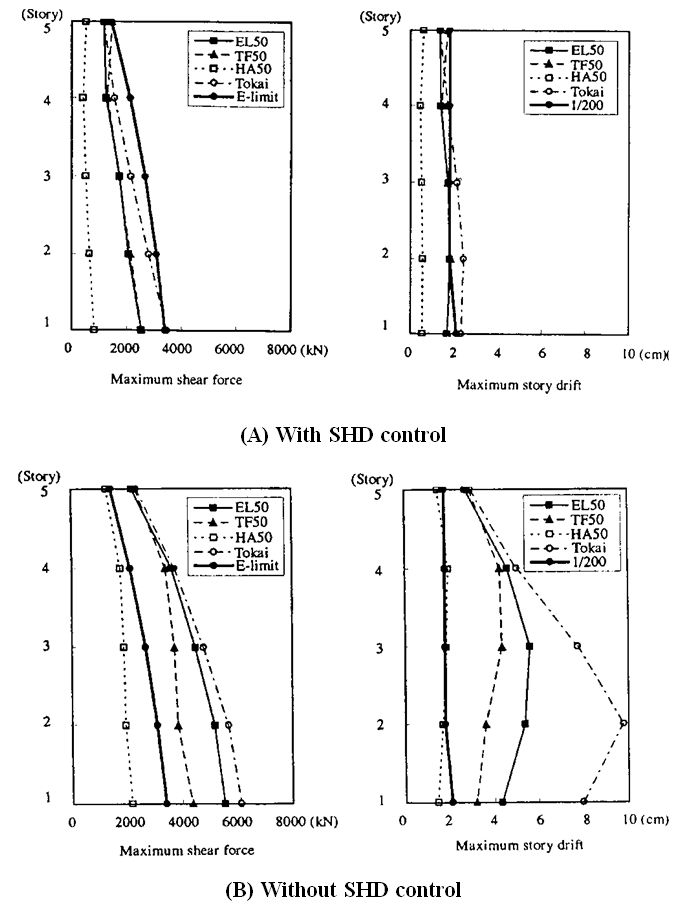 | Figure 14. Maximum shear force and storey drift of the building with and without SHD control [15] |
5. Base Isolation
- A base isolation system decouples the superstructure from the seismic ground motions, extending the fundamental period of excitation. Base isolation is employed where safety is the major concern. Base isolators consist of rubber pads and lead rubber bearing to reduce the seismic vibration. This system provides isolation only in horizontal direction and is rigid or semi-rigid in vertical direction. The isolation system does not absorb energy but deflects it through dynamics of the structure [16-17].
5.1. Seismic Response of Base Isolated Structure in Real-time Application
- USC hospital located in Los Angeles, California is a 8-storey steel braced building with 68 lead rubber isolators and 81 elastomeric isolators [18]. The performance evaluated is compared with fixed base conditions. It responded in the inelastic range with the superstructure being elastic. The response is illustrated in Fig. 15.
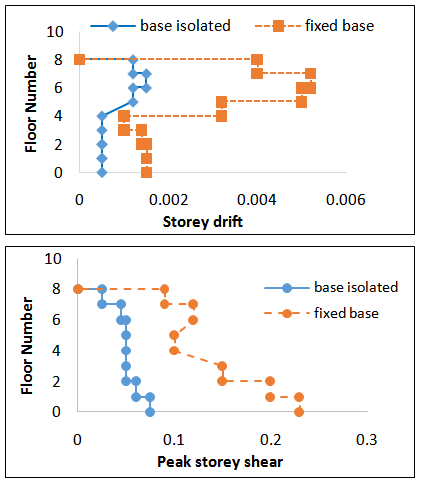 | Figure 15. Peak storey shear and drift of USC hospital during Northridge earthquake [18] |
6. Conclusions
- A review of passive, active and semi-active control has revealed that semi-active system is profitable for seismic protection when compared to active and passive systems. Base isolators provide flexibility to massive structures situated on rigid soils against earthquakes. Combination of base isolators with viscous dampers perform extremely good even under strong earthquakes. A brief description of various forms of energy dissipation devices and their real time application in structures are discussed in this paper. Finally it is confirmed that base isolation is most effective in controlling the response of the structures during severe earthquakes.
ACKNOWLEDGEMENTS
- This paper is published with the kind permission of the Director, CSIR-Structural Engineering Research centre, Chennai, India.
References
| [1] | T.T. Soong, Spencer B.F, (2002), “Supplemental energy dissipation: state-of-the-art and state-of-the practice”, Journal of engineering structures, Vol-24(3), pp. 243-259. |
| [2] | M.D. Symans., F.A. Charney., A.S. Whitttaker (2008), “Energy dissipation systems for seismic application: current practice and recent developments”, Journal of structural engineering, Vol-134(1), pp. 3-21. |
| [3] | Bergman, D. M., and Goel, S. C, (1987), “Evaluation of Cyclic Testing of Steel-Plate Device for Added Damping and Stiffness”, Report No. UMCE 87-10, University of Michigan, Ann Arbor, Michigan. |
| [4] | Ahmed Elgamal., and Michael Fraser (2004), “Seismic isolation and energy dissipation systems”, Earthquake engineering, Prepared from Dr. Benzoni SE207 base isolation course. |
| [5] | C.S. Tsai., H.H Lee, (1993), “Application of viscoelastic dampers to high rise buildings”, Journal of structural engineering, ASCE, Vol-119(4), pp. 1222-1233. |
| [6] | Julius Marko (2006), “Influence of damping systems on building structures subject to seismic effect”, Ph.D thesis, Queensland University of Technology, Brisbane, Australia. |
| [7] | M.D. Symans., Michael C. Constantinuo (1999), “Semi-active control systems for seismic protection of structures: a state-of-the-art review”, Journal of engineering structures, Vol-21(6), pp. 469-487. |
| [8] | Tamura Yukio, Fujji Tamio, Wakahara Toshihiro, Koshsaka Ryuichi, (1995), “Effectiveness of tuned liquid dampers under wind excitation”, Journal of engineering structures, Vol-17(9), pp.609-621. |
| [9] | Li Gang and Li Hongnan, (2007), “Earthquake-Resistant Design of RC Frame with Dual Functions metallic dampers”, Journal of seismic engineering, Vol-8, pp.43-53. |
| [10] | Claude pasquin, Normand Leboeuf, R. Tina Pall, Avtar Pall (2004), “Friction dampers for seismic rehabilitation of Eaton’s building, Montreal”, Proceedings of the 13th WCEE, Vancouver. B.C, Canada, August 1-6, Paper no. 1949. |
| [11] | Samuele Infanti, Jamieson Robinson, Rob Smith (2008), “Viscous dampers for high-rise buildings”, Proceedings of 14th WCEE, Beijing, China, October 12-17. |
| [12] | Masashi Yamamoto and Takayuki Sone, (2014), “Behavior of active mass damper (AMD) installed in high-rise building during 2011 earthquake off Pacific coast of Tohoku and verification of regenerating system of AMD based on monitoring”, Journal of structural control and health monitoring, Vol-21(4), pp. 634-647. |
| [13] | Kurino Haruhiko., Matsunaga Yoshinori. Yamada Toshikazu (2004), “High performance passive hydraulic damper with semi-active Characteristics”, Proceedings of the 13th WCEE, Vancouver. B.C, Canada, August 1-6, paper No. 33. |
| [14] | Mariacristina Spizzuoco., Antonio Ochiuozi, (2004), “performance of a semi-active MR control system for earthquake protection”, Proceedings of the 13th WCEE, Vancouver, B.C, Canada, August 1-6, paper no. 2525. |
| [15] | B.F. Spencer, S. Nagarjaiah (2003), “State of the art of structural control”, Journal of structural engineering, Vol-129(7), pp. 845-856. |
| [16] | Aiken. D. Ian, (1998), “Testing of seismic isolators and dampers-considerations and limitations”, Proceedings of Structural engineering world congress, San Francisco, California. |
| [17] | Kubilay Kaptan, (2013), “Seismic base isolation and energy absorbing devices”, European scientific journal, Vol-9(18), pp. 41-54. |
| [18] | Satish Nagarajaiah, Sun Xiaohong (2000), “Response of base-isolated USC hospital building in Northridge earthquake”, Journal of structural engineering, Vol-126(10), pp. 1177-1186. |
 Abstract
Abstract Reference
Reference Full-Text PDF
Full-Text PDF Full-text HTML
Full-text HTML